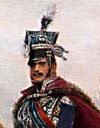 |
| La Manoeuver sur les derrieres schematic |
La manoeuvre sur les derrieres was employed no less than thirty times between 1796 and 1815 and was designed to crush a single enemy army which had strayed out of close supporting distance of its allies or supporting forces. Its aim was to achieve a favorable battle situation on Napoleon's own terms. The Emperor, while he was quite prepared "to break eggs to make omlettes," as von Clauswitz puts it, was always eager to gain total victory for a minimum expenditure of manpower and effort. Consequently he disliked having to force a full-scale, fully arrayed frontal battle -- that is to say, marching directly against the enemy to fight him on ground of his (the adversary's) choosing, for such battles were inevitably expensive and rarely conclusive (Borodino in 1812 is a case in point). Instead, whenever possible, after pinning the foe frontally by a feint attack, he marched his main army by the quickest possible "safe" route, hidden by the cavalry screen and natural obstacles, to place himself on the rear or flank of his opponent. Once this move had been successfully achieved, he occupied a natural barrier or "strategical curtain" (usually a river line o mountain range), ordered the blocking of all crossings, and thus isolated his intended victim from his rear depots and reduced his chances of reinforcement. Thereafter, Napoleon advanced relentlessly toward the foe's army, offering him only two alternatives -- to fight for survival on ground not of his own choosing, or to surrender.
The advantages afforded by such a strategy are obvious. The enemy army would be both taken by surprise and almost certainly demoralized by the sudden apparition of the enemy army in its rear, cutting its communications. The opposing general could attempt one of three things to try and remedy the situation; if he was bold enough, he could continue his advance against the "pinning" force; or, second, he could try to place himself across the main French lines of communication -- which would necessarily be extensive; or, third, h could order an immediate retreat toward the main French army in the hope of forcing a way through to reopen his communications -- in other words, accepting a battle.
~ The Campaigns of Napoleon, D. Chandler, p. 163





















































2 comments:
This strategy was devastatingly successful at Ulm in 1805 - possibly its crowning achievement. It was also the basis of Ambrose Burnside's plan after the Fredericksburg debacle, but was stymied by Virginia's winter weather. Joe Hooker thought well enough of it to try it on in May 1863, and had he pushed it home, might have won a signal victory at Chancellorsville.
The "manoeuvre sur les derrieres" was a strategy best suited to superior numbers. Robert E. Lee got away with its application with inferior numbers in the Second Manassas campaign, but was less successful with it in the Gettysburg campaign and some months later in Virginia. I believe the vast inferiority in resources told against a decisive CSA success.
I'm inclined to think of U.S. Grant's closing operations around Vicksburg also as such a manoeuvre, rather creatively applied. This really was decisive: once encircled (contrary to Joe Johnston's wishes and orders), Pemberton's army had no chance.
I had not viewed the dash from the Boulonge coast as such a maneuver, though I can see that bu using the Danube as the first barrier, and perhaps one of the southern tributaries as the rear barrier it could be seen as such.
For the American Civil War, there were many that attempted to re-use the Napoleonic strategies and tactics. The problem with them all was the increase in firepower and rates of fire had not been taken into account. Moreover there were no officers like the Marshalate or well trained and experienced NCO's to keep up the morale on the march. Not until Sherman was on his epic march were the officers and NCO up to the level needed to accomplish such complex maneuvers, and by then the Union did not need such finesse.
Thank you for the thought-filled comment.
Post a Comment